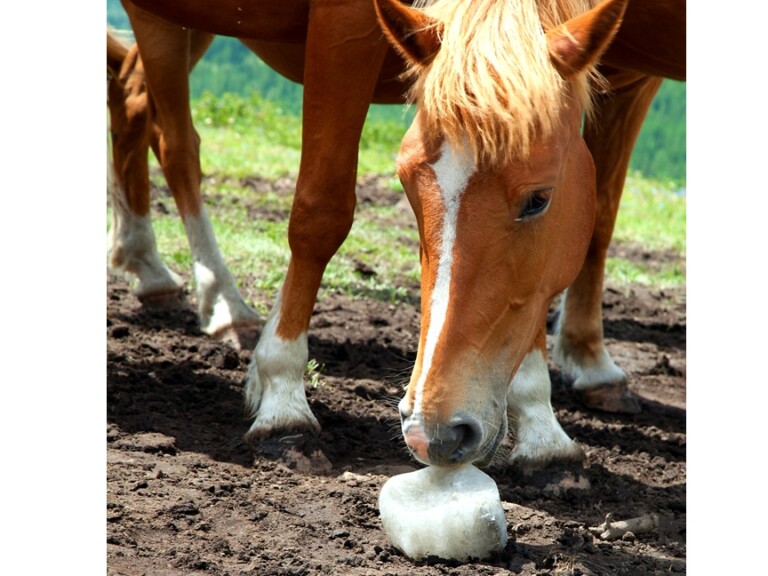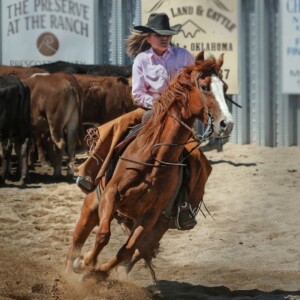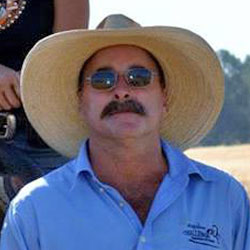
The Importance Of Salt In A Horse’s Diet And Is My Horse Tying Up? We all know that salt is important to our horses diet, right? If you are new to horse ownership you might not know yet. It is crucial that you learn about the health risks involved when a horse isn’t receiving enough salt/sodium in the diet. Sodium is the main electrolyte found in the blood. If your horse is not getting enough salt/sodium and the levels become low, the blood can’t hold enough water. This causes a chain reaction, causing the adrenal gland to release the hormone aldosterone. When the kidneys hold on to sodium, they excrete potassium in its place, creating an imbalance. This can lead to rapid heart rates, inadequate sweating which can cause your horse to avoid drinking water, which can lead to impaction colic and rhabdomyolysis “tying up.”

What is Tying Up?
Tying up is a term used to describe a variety of muscle disorders in the horse that cause cramping and muscle damage during exercise. The medical term for tying up is exertional rhabdomyolysis. Meaning it occurs during exercise, and rhabdomyolysis meaning rapid breakdown of muscle cells. Some horses may never have an episode their entire life and with others it can reoccur often. It is thought that when a horse suffers fron chronic rhabdomyolysis, that is can be genetic and it is also said that horses of certain breeds are more prone. The most common cause of tying up is overexertion. If that is the cause then the rider/trainer is pushing the horse beyond it’s level of fitness/conditioning. I say if it is happening often, one must stop and take a look at their training and nutritional programs. Is your horse getting enough electrolytes, sodium, calcium, phosphorus and magnesium in its daily diet?


How do you know if your horse is Tying Up?
You go out to ride your horse, you’re running late and you don’t take the time for proper warm up. 15 – 20 minutes into your ride, your horse starts to lose forward motion and you notice a stiff, stilted gait. You’re focused on your ride and/or competition so you demand he continues. Soon after your horse starts to sweat profusely, his respiration increases and when you finally allow him to stop, your horse is now locked in place and refuses to move forward altogether. Is your horse tying up?
Things You Can Do
Provide a plain white salt block. I like to keep it next to the water trough. You can keep an eye on it there to make sure it is being used and know when it needs to be replaced. My horses prefer the smaller “brick size” salt blocks, especially if I take a hammer and break it up a bit. Don’t use mineral blocks. The minerals may have a bitter taste which will not motivate the horse to use it. The minerals used in the blocks are not easily absorbed and if you already are feeding a mineral horse supplement, they don’t need more minerals coming from the block. Don’t use molasses sweetened salt blocks!
If you horse isn’t using the salt block then you can provide salt by adding it to your horses feed. Kosher salt is preferred because it is coarser, but table salt is fine. If you are feeding a commercial horse feed or a vitamin/mineral horse supplement, avoid iodized salt. Your horse is most likely getting enough iodine from the supplement you are feeding. Provide two to four level tablespoons of salt per day, depending on the work level of your horse. If you have a hard working performance horse, they will require the higher amounts. Divide into at least two separate daily servings. Also be mindful of hot, humid weather. When your horse is outside sweating more than normal, that is another time that you will want to make sure they are getting the higher dosage. Always keep some electrolytes on hand, both at the barn and in your horse trailer.
Balancing of Minerals
Lastly, diet is important! It is thought that an imbalance in the ratio of calcium to phosphorus has been shown to be significant in some cases of Exertional Rhabdomyolysis. Read your feed tag labels and know what you are feeding. The calcium and phosphorus ratios should be 2:1. Equine Challenge Forage Specific Vitamins & Minerals takes care of this in both the Alfalfa and Grass formulas.
It is also thought that high NSC intake can lead to sporadic tying up. If your horse is out in pasture, be mindful of the times of day and times of year that pasture grasses are at their highest in sugar levels, read more about pasture grasses. Pasture intake needs to be managed carefully as grass can be a significant source of water-soluble carbohydrates as part of the non-starch carbohydrate fraction (NSC), much of this being made up by sucrose sugar and fructan. The NSC content of grass is also highly variable. Be careful during periods where grass growth is increased and highest in sugar levels and monitor the horses pasture time accordingly.
Forage alone does not usually provide a performance horse proper caloric or vitamin/mineral requirements. Grain with moderate nonstructural carbohydrates (NSC) and protein will address the performance horse demands, Vitamin E and selenium deficiencies can potentially increase a horse’s risk of tying up. Feel free to email or call us for information on our Vit E + Selenium supplements. Vitamin E is usually found in adequate amounts in grass hays but it can be supplemented if needed. Be sure to read your feed tag labels on any supplement you are feeding to ensure you’re not feeding it in excess. The horse’s body converts starches from easily digestible grains such as oats into readily available glucose and glycogen for energy.
Proper amounts of protein is needed for maintenance requirements and some excess can be converted to energy. Too much can lead to dehydration. Protein requirements for a performance horse is typically 8-10% of total diet, so keep this in mind when selecting a commercial feed and combining it with hay.
Horses lose electrolytes to include salt, calcium, and potassium in sweat, urine, and manure. Providing your endurance or performance horse with trace minerals is a wise choice along with electrolytes before, during and after competitions.
And Lastly…
These are guidelines, all horses are individual so you must adjust based on your horse’s individual nutritional needs. Provide proper forage, grain, vitamins and minerals and keep your horse properly hydrated to help to decrease the chances of your horse tying up. And always consult with your Veterinarian when necessary.
Kathy Hartwig
Equine Challenge Supplements

